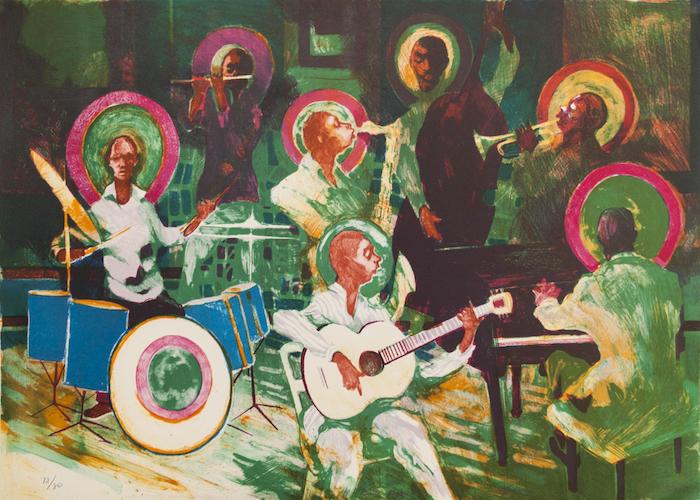
Blues Band
Paul Keene
- 1990
- Offset Lithograph
- Image/sheet: 22 x 30"
- 80 prints in this edition
About the Print
From the Artist
Speculation is the only way possible for me to indicate why I follow one direction or another. Happenings on paper or canvas are predictable up to a critical point for me. Beyond this, intuition and instinct take over. I only know that any verbal statement can only give vague clues as to why I pursue a certain direction in working and thinking. For me the subject matter simply becomes a vehicle used to help discover the mystery. Then the idea becomes the mystery that must be made real; it is the means by which I render some of what I assume I know with the unknown. I hang on and take the wild ride.
—From Brandywine Workshop and Archives records
My style is how I see things, how they filter through you. I paint intuitively. I can’t plot and plan…it’s all in my head and it depends upon the color and then I get a big idea of what I’m supposed to do and then I try to do it. If painting your art makes any sense, then it has to come out, and sometimes you wish it to come out with much more enthusiasm or from much more excitement than it does, but you have to be proud. After a certain point, it’s putting this together, and you just plot and scrape away…you either throw it away or it leads you to a new idea. So, you start a new canvas, or you take all of that out, but one little place that works, then you start again.
—From https://www.youtube.com/watch?v=Oz72bw0kOoo, accessed 6-25-2021
Blues Band pays homage to blues music, which originated in the Southern Mississippi Delta early in the 20th century to express the joys and frustrations of African American life during this period of racial oppression. In Keene’s print, each musician is given a halo to signify the spiritual nature of the music and showcase the individuals in an angelic light. The artist arranged the musicians across the picture plane to give maximum visual importance to their act of playing and to establish a formal visual relationship that forms a circle tying all the players together. Keene uses colors, layered one over the other, to create a physical space which suggests that the musicians are floating on air.
—From Brandywine Workshop and Archives records
Through deeply personal pictures Paul Keene brings together the painter’s visceral love of color with the mystery of memory and the subconscious mind. Mr. Keene is a quiet man who chooses to speak with line, shape, and—most passionately—with color. Always avoiding the didactic, he gives us hints and suggestions, then leaves us to discover our own meaning in his work.
—Bruce Katsiff, from https://bucksco.michenerartmuseum.org/artists/paul-f-keene, accessed 6-25-2021

Paul Keene
American
Born August 24, 1920
Philadelphia, PA
Died November 26, 2009
Warrington, PA
About the Artist
Philadelphia-born painter, printmaker, and muralist Paul F. Keene, Jr., received a BFA, BS, and MFA from Temple University, Philadelphia. He also studied at the Academie Julian, Paris, France. There he helped found Galerie 8, a collective gallery for American artists working in Paris.
Keene’s works can be found around the world at institutions including the Philadelphia Museum of Art, African American Museum in Philadelphia, Pennsylvania Academy of the Fine Arts, and Woodmere Art Museum, Philadelphia; Michener Art Museum, Doylestown, PA; The British Museum, London; Nigerian National Museum, Lagos; Dallas Museum of Art, TX; and Tucson Museum of Art, AZ.
After teaching at the Philadelphia College of Art (now University of the Arts), Keene went on to help establish the art department at Bucks County Community College, Newtown, PA, where he retired as professor emeritus. He lived and practiced his art in Warrington, PA, until his death in 2009.
—From Brandywine Workshop and Archives records
Curriculum Connections
Suggested Topics for Expressive Writing
Expressive Writing
The writings of Haki R. Madhubuti reflect a similar way of stereotyping as the word-prints of Edgar Heap of Birds. People of African descent are disproportionately represented in entertainment—as dancers and singers, particularly—and in professional sports. They are perceived as physically strong and fast. In American society, Blacks may entertain, play sports — or cook and clean. Outside of those realms, however, Blacks both with and without advanced education, social prominence, and financial success are considered dangerous, therefore representing a threatening presence at both ends of the socioeconomic spectrum.
Our abilities as viewers to understand the messages and connections that the artists hope their imagery will convey is largely based on the extent of our own experiences and information that we bring to viewing and interpreting the artwork. In many countries, these types of messages are not brought to broad public attention and are often considered subversive.
Questions to Consider
- Why are some people considered a threat while others are not?
- Why is there education inequality in most developed countries?
- Who benefits from stereotyping others?
Related Media
- “America Calling” by Haki R. Madhubuti (Don L. Lee)
- “AWARENESS” by Haki R. Madhubuti (Don L. Lee)
- “Middle Passage” by Robert Hayden
- Amistad (1997 film) directed by Steven Spielberg
- Just Mercy (2019 film) directed and written by Destin Daniel Cretton
- King in the Wilderness (2018 documentary) directed by Peter W. Kunhardt
- Committed to Memory: The Art of the Slave Ship Icon by Cheryl Finley, PhD (2018)